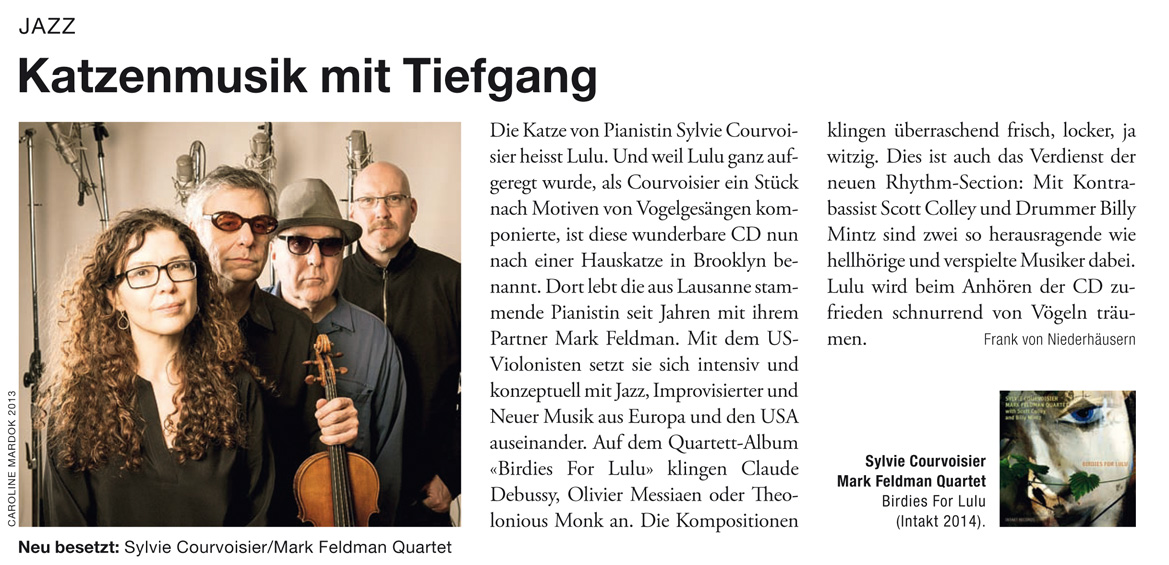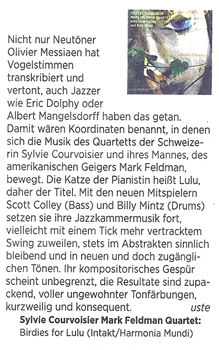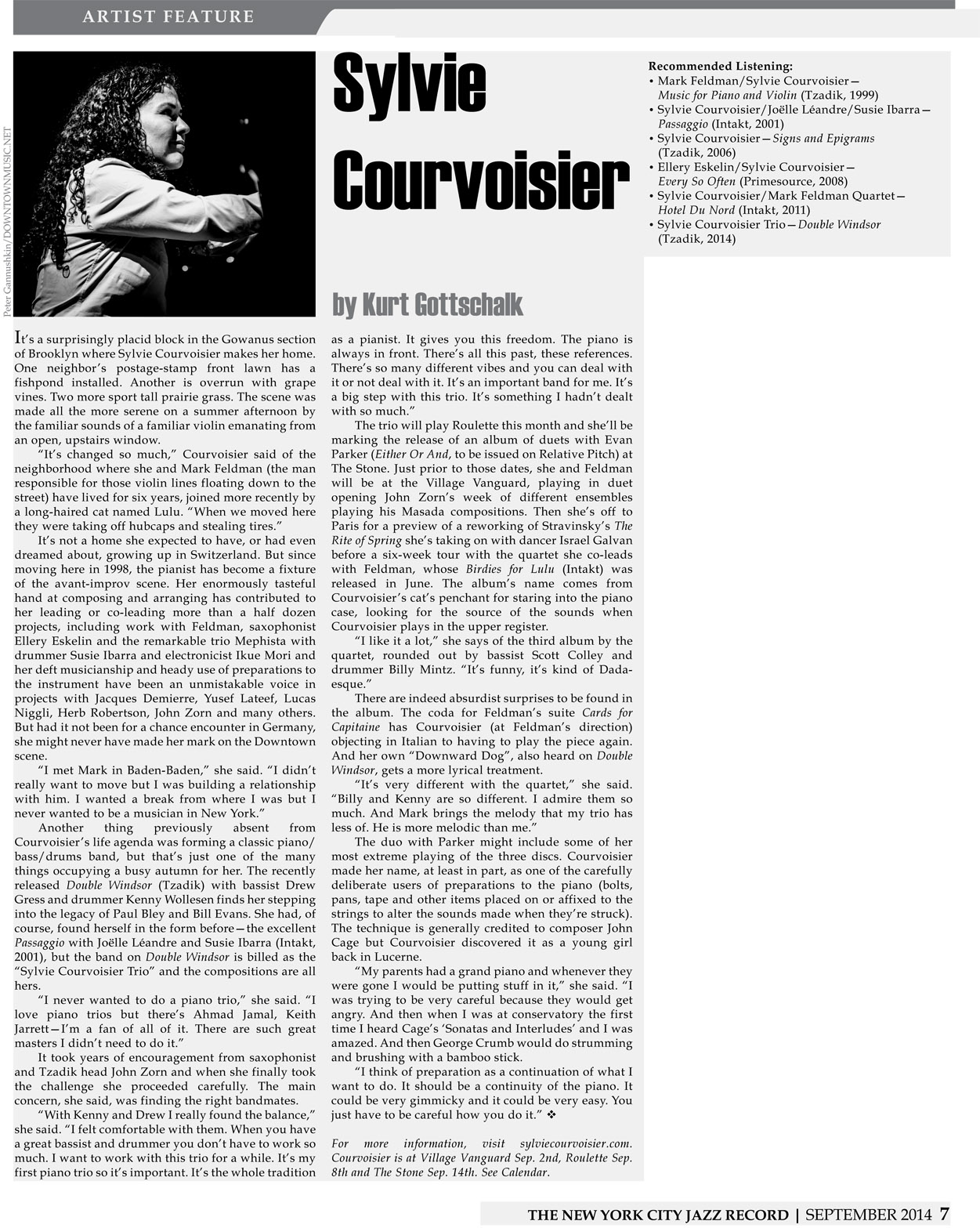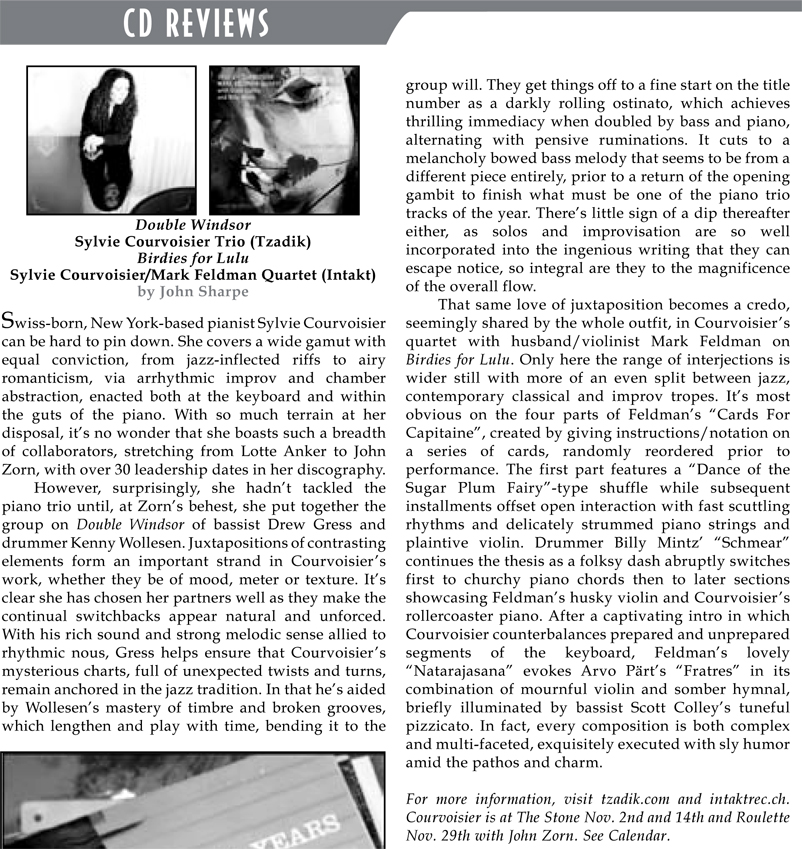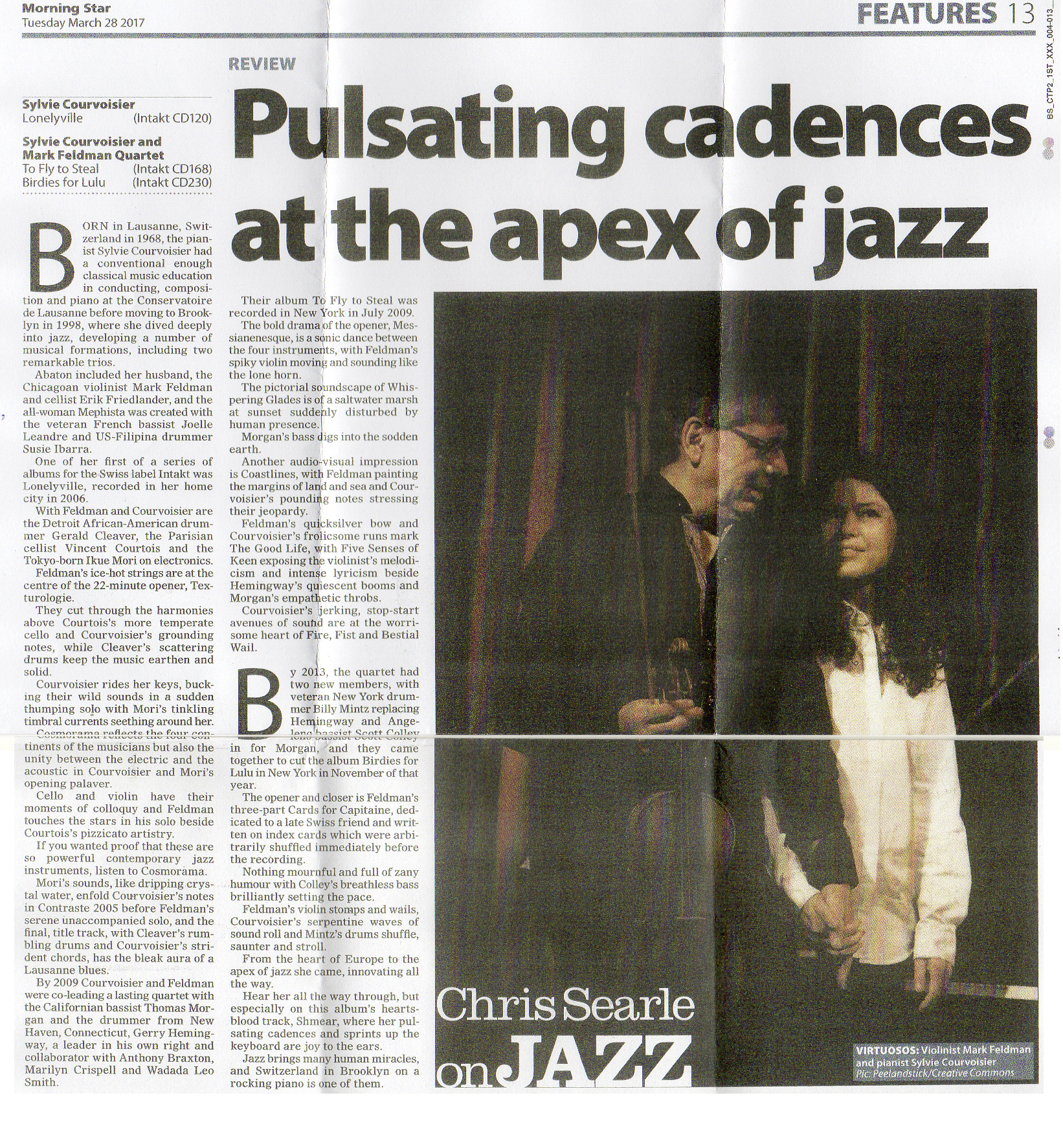INTAKT RECORDS – CD-REVIEWS
SYLVIE COURVOISIER - MARK FELDMAN QUARTET
BIRDIES FOR LULU
Intakt CD 230 / 2014
Anything goes. Man kann die halbe Mannschaft auswechseln, und bleibt dennoch das SYLVIE COURVOISIER MARK FELDMAN QUARTET. Scott Colley am Bass und Billy Mintz an den Drums sind konfrontiert und dabei doch selber auch schon aktiv beteiligt an einem Programm, in dem jedes einzelne Teilstück die Kaleidoskopik des Ganzen wiederholt. Mise en abyme wohin man blickt. Birdies for Lulu (Intakt CD 230) im Allgemeinen und 'Cards for Captaine' im Besonderen sind einem verstorbenen Freund gewidmet, dem Schweizer Indologen Yves Ramseier (1956 - 2013). Der Duktus der Musik ist jedoch alles andere als elegisch, die Kapriolen häufen sich derart, dass ich da lieber von Capriccios sprechen möchte. Das 'Cards'-Stück mischt komponiertes und aleatorisches Material, verwirft einen Teil von Letzterem, um es studiomanipulativ doch wieder an passenderer Stelle einzufügen, oder als Coda anzuhängen. Es gibt nur eine Richtschnur, Spielwitz en gros und en detail. Feldman brilliert bei 'Cards' mit schillernden Bogenkratzern über einem animierten Puls, mit stenografierten Kürzeln, mit Flötentönchen am Steg, während Courvoisier von kristallinem Gesplitter zu Staubgewedel wechselt und dann von Slideeffekten zu debussyeskem Wellengekräusel und versonnenen, pizzikatobepickten Impressionen, bis ein Paukenschlag einen schnell ins Trockene schlüpfen lässt. 'Shmear' hetzt wie ein Hund hinterm Stöckchen her, kontrastiert mit einer Kürzesthymne, wetterwendischem Gegrummel und Courvoisiers röhrenglockig läutender Linker zu violinistischen Paganinismen, das sie mit merkurialem Geperle erwidert - bis plötzlich die getragene Hymnik wiederkehrt, während der Hund immer noch sein Stöckchen jagt. Danach kann man sich yogamäßig in 'Natarajasana' versenken, sich vom Piano besänftigen, von der Violine einspinnen, vom Bass die Chakras massieren lassen. Bei 'Downward Dog' spielt Courvoisier ihren Monk-Joker, bei 'Birdies for Lulu' ist Messiaensche Vogeligkeit Trumpf, was vogelfresserische Gelüste bei Courvoisiers Katze weckt. Flatterhaftigkeit, besser wohl: ein Sich-Entziehen ist auch das Thema von 'Travesuras', das sich auf Das böse Mädchen von Mario Vargas Llosa bezieht. 'Coda for Captaine' bringt dann mit einer geigerischen Endlosrille und clowneskem Gestus ein ganzes Buket möglicher Finale.
Wie ein munteres Uhrwerk nahenden Unheils klingt der Anfang dieses Albums, ein einprägsames Klangmotiv voller Reminiszenzen halbdunkler Welten. Scheinbar unaufhaltsam läuft es, aber dann beginnt es drumherum zu schaben und zu knarzen. Solcherart aufgeladene Klangmotive gehen einher mit verblüffenden Übergangsqualitäten und Umschwüngen, die aufhorchen und aufschauen lassen. Es treffen erstaunliche klangliche Kernmotive aufeinander, verzahnen sich miteinander, umspielen sich frech oder ehrbietig, dreist oder behutsam, flüsternd oder krachend.
EUROPE MEDIA CHART - JUNE 2014
This is the third disc from Sylvie and Mark's quartet although they have a new rhythm team this time around. This is probably due to the fact that their previous drummer, Gerry Hemingway moved to Switzerland to teach a few years back. Their current rhythm team features two of Downtown's best players, both of whom are in-demand with dozens of discs from Mr. Colley (for David Binney, Jim Hall and Andrew Hill) and several from Mr. Mintz for the Nine Winds label before he moved to NYC. I listened to this twice the day it came in and was blown away by this disc. Over the past few years, Ms. Courvoisier and Mr. Feldman have played a number of duo and quartet sets and have been consistently amazing! Every time Sylvie plays at The Stone or anywhere else, someone in the audience is overheard saying that there is no other pianist who can do what Sylvie does, especially her inside-the-piano playing which puts her in a class of her own. This has got to be the CD of the month although Ms. Courvoisier's trio on Tzadik which came out last week is nearly as incredible as this one!
Pianist Sylvie Courvoisier and violinist Mark Feldman are a dynamic duo within the neoteric strategies of modern jazz, coupled with their substantial artistic output. They intersperse classical inferences with shades of folk, avant-garde schemas, and bristling improvisational segments into the big picture. This incarnation of the quartet now features upper-echelon session bassist Scott Colley and venerable drummer Billy Mintz. Essentially, the artists enrich the avant-classical genre by cultivating an undertow framed on swing, bop and concise opuses tinted with the appropriate doses of razzle-dazzle and free-flight mechanisms. Birdies for Lulu is a revelation of unanticipated surprises via the quartet's seamless execution, also rooted in capacious passages, striking tonal contrasts, and a consortium of dips and spikes. The frontline enlivens the momentum with effortlessly articulated and mesmeric unison choruses amid somber dirges and soaring breakouts. Variety is a common denominator from start to finish. For example on "Birdies for Lulu," Mintz instills a Middle Eastern backdrop with his delicate toms patterns, shaded by Courvoisier's dainty voicings and Feldman's resounding extended notes. Another important aspect pertains to how the band commingles assertive jazz choruses with capacious sound-sculpting tactics and softly moving mosaics, as you could hear the proverbial pin drop in between passages. But they close out the album with a calm-before-the-storm outlook on "Code for Capitaine," where the soloists engage in call and response processes with swirling intensity and asymmetrical stop and start grooves, offset when Courvoisier plucks the piano strings atop Colley's sawing arco notes. Yet Mintz adds another savory component with his colossal snare rolls as the quartet reshapes the proceedings with hand-claps, leading to a pleasantly bizarre finale. Indeed, Birdies for Lulu is a leading-edge exposition that accentuates the quartet's sophisticated approach and ability to sustain a high form factor of entertainment at all times.
Un simple coup d'oeil au personnel permet de constater que la paire Courvoisier/Feldman est encore en train d'évoluer, de bouger, de se situer sur des territoires où on ne les attendait pas obligatoirement. Former un quartet avec deux instrumentistes fortement connotés « jazzmen », c'est plus qu'un geste, c'est un acte. Même si - ironie du rapport entre les mots et les choses - l'intégrité des uns et des autres reste, évidemment, intacte. Comme un label qui ne bougerait pas. Ces oiseaux pour Lulu - le nom du chat de Sylvie et Mark - se goûtent d'entrée avec la première partie d'une suite dédiée à un ami linguiste décédé (Yves Ramseier), une minute et quarante cinq secondes étonnantes, une pièce en forme de poursuite haletante qui pourrait très bien fonctionner comme indicatif d'une série policière dans la grande tradition des musiques hollywoodiennes. Le ton est donné. Car la suite de ces « Cards For Capitaine » montre trois choses : d'une part, que la pianiste et le violoniste ne renoncent en rien à leur manière habituelle d'écrire, ou de faire sonner leurs instruments ; d'autre part, que Scott Colley et Billy Mintz (un nouveau venu d'âge mûr, paraît-il) apportent sans réserve la dimension purement « jazz » de leur jeu, et enfin que la rencontre s'opère sans le moindre heurt, comme si cela allait de soi. Et cela va, en effet. La troisième partie de la suite, en particulier, touche au plus près, avec une tendre évocation de la musique indienne et ces effets d'auto-harp dont Sylvie est devenue coutumière. Le dernier morceau du disque est une « coda » pour ce « Capitaine », émue mais sans pathos. Le dédicataire était un spécialiste du sanscrit. C'est Billy Mintz qui a apporté « Shmear », avec son introduction en tempo ultra-rapide suivi d'une sorte d'intermède pianistique « alla Schubert » et d'un moment de suspens improvisé. Cadence du violon, puis relance de l'infernal tempo. « Natarajasana » offre par contraste un calme méditatif, énoncé au piano avant que les autres instruments viennent contribuer à cet épisode apaisé. Les grands écarts mélodiques de « Downward Dog » offrent aussi de beaux espaces à Scott Colley, et Sylvie Courvoisier s'y affirme comme une pianiste de jazz fort sensible. « Birdies For Lulu » revient davantage sur les chemins déjà empruntés par le couple, avec des effets d'imitation amusants (oiseau, chat), puis l'on s'achemine vers un « Travesuras » aux aspects latins, avant la très émouvante « Coda » déjà évoquée. Cette très belle session montre bien que le fossé entre « musiques improvisées » et jazz n'est pas aussi profond qu'on l'imagine. Car sans rien changer à leur façon de concevoir l'écriture et le jeu instrumental, Mark Feldman et Sylvie Courvoisier ont pu s'adjoindre deux authentiques et réputés jazzmen sans la moindre rupture dans la continuité. Cette unité, en tous cas cette volonté d'unité, doit être relevée et encouragée. Elle produit ici une musique passionnante, vive, et astucieusement rebondissante.
Ulrich Steinmetzger, Leizpziger Volkszeitung, 9.8.2014
4 stars
Kraftvoll swingen die vier zu Beginn drauf los. Geiger Mark Feldman und Pianistin Sylvie Courvoisier haben ihrem Quartett einen Relaunch verpasst und mit dem Bassisten Scott Colley und dem Schlagzeuger Billy Mintz frische Kräfte ins Boot geholt. Insgesamt ist ihre Musik kompakter geworden. Fein aufeinander abgestimmtes Tun bestimmt die Sounds. Nach dem jazzigen Beginn ein plötzlicher Bruch, hingeworfene Klangpixel zwischen Geige und dem erstklassigen Rhythmusteam. Immer wieder werden Bezüge zur zeitgenössischen Kammermusik hergestellt, fast romantisch wirken manche von Courvoisiers Pianoexkursen. Beispielhaft im titelgebenden Stück Birdies for Lulu. Ganz wunderbar dabei Feldmans sehnsuchtsvolles, wie von mühsam unterdrückter Leidenschaft geprägtes Geigenspiel. Insgesamt ein höchst empfehlenswerter Tonträger, der sich schlüssig in die Serie hervorragender CDs einreiht, die Feldman und Courvoisier für Intakt eingespielt haben.
Swiss pianist Sylvie Courvoisier, having lived in the United States for nearly two decades, is something rare: a musician who's sustained her European identity and become an integral part of the American scene. That dual nature is captured on Double Windsor and Birdies for Lulu. On both of these excellent albums, Courvoisier sticks to a space she's explored since the beginning of her career stateside – somewhere between written and improvised music, a hybrid of contemporary classical music, jazz, and the avant-garde. Years ago she married into New York's creative-music community (her husband is violinist Mark Feldman), but she's carved out her own spot on what was once the Downtown Scene, that now disparate crew of players who, despite splintering across the boroughs, are still routinely found in the East Village, especially at John Zorn's room, the Stone. You might lump Courvoisier (who's 45) in with the generation between, say, drummer Tyshawn Sorey (34) and guitarist Marc Ribot (60).
They begin with a suite, "Cards for Capitaine", according to the liner notes dedicated to an old friend, an expert in Sanskrit. Old languages come to us in shards and fragments, torn loose from their moorings and it is up to us to find meaning, renew acquaintance. Mark Feldman sketched musical segments on index cards and let indeterminacy coupled with his own evoked memories combine to create a barrage of snippets, some short and unresolved some drawn out. Let me give you some impressions in poor words : on a repeating left hand theme, bows scrape and weave and smear, pizzicatos punctuate, bass takes over repeating undulations to spread a bed for romantic violin and Debussy-esque skittering, leading to strumming the piano and coaxing the violin into the gentle calm of an uncluttered mountain lake, strings are pulled and bowed and upon mallet sounds piano enters the purely romantic and points the violin and bowed bass into the hazy distance. There be whales out there. And shifting shoals of herring. Then over to the driving pulse of "Shmear". Not for long though, the piano finds the beginnings of an anthem, gets bored quickly and hands things over to other strings, low bass, sparse sounds, Shostakovich country (to me), the violin launching into a mad melody and the piano coming in from the left and bringing the whole to a rapturous boil. And back to the unfinished anthem, not finishing it this time. The quiet center, the eye of the hurricane bears the name of a yoga posture and holds it nicely. Prolonged breathing (though no wind instruments are present) with a subtle bass solo, muscles relax, tendons lengthen : "Natarajasana" is a glorious heart-opener that asks us to be stable yet at ease, committed yet non-attached, and fully engaged yet at peace. "Downward Dog" brings you back to life after a long and tiring day at the office and allows Sylvie Courvoisier ample space for a dense solo. Wereupon "Birdies for Lulu" call and take you out in the woods where call and response flitter through the dappled shadows. Messiaen anyone? "Travesuras" then, playing games, hopscotching, hithering and thithering and the final track "Coda for Capitaine" brings us round to the beginning, riverrun, the eternal present wherein jazz exists. "Jazz is and always has been more of an attitude than a style." (Art Lange). This is highly original and new music, steeped in tradition but treated with the measured, ordered lucidity that brings ineluctable joy to the paradox of controlled freedom. Listen. Hugo Truyens, freejazzblog, USA, September 2014
Chris Joris, Jazzmozaiek, Belgium, September 2014
Le duo Sylvie Courvoisier/Mark Feldman retrouve ici une section rythmique, et quelle rythmique !, pour un disque assez époustouflant. Une musique brillante, foisonnante, presque échevelée parfois, dynamique ou au contraire concentrée, pleine de surprises et de références, une musique savante et de très haut niveau qu'on écoute oreilles grandes ouvertes ! (le quartette va se produire prochainement en France, notamment à Banlieues Bleues). OUI
John Sharp, New York City Jazz Record, November 2014
Sur fond de poursuite jazz, un violon désosse la corde : voici Mark Feldman. Les aigus d'un piano se déversent à grands flots sur la maison ternaire : c'est Sylvie Courvoisier. La contrebasse ronronne un blues racé : c'est Scott Colley. La batterie rectifie aux balais les effigies antiques : c'est Billy Mintz. Le nouveau quartet Courvosier-Feldman implore au jazz de ne pas trop noircir la page. Y résistent les écritures contemporaines d'antan, le fantôme de Schubert, les traits vifs et saillants, les épandages d'aigus d'un duo toujours aussi éblouissant. De ces compositions aux mille-facettes (soit l'art de sauter du coq à l'âne sans s'en apercevoir), on retiendra l'intensité du jeu, les basses paroles murmurées, les lances tranchantes. Charme et légèreté ici. Encore plus que d'ordinaire.
Ken Vos, Jazzism, Maart 2015, Nederlande
|

